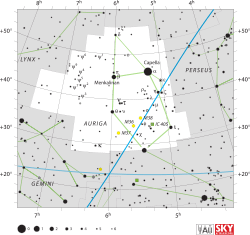Tau Aurigae

| |
| Observation data Epoch J2000 Equinox J2000 | |
|---|---|
| Constellation | Auriga |
| Right ascension | 05h 49m 10.43826s[1] |
| Declination | +39° 10′ 51.8627″[1] |
| Apparent magnitude (V) | 4.505[2] |
| Characteristics | |
| Spectral type | G8 III[3] |
| U−B color index | +0.692[2] |
| B−V color index | +0.956[2] |
| R−I color index | 0.49 |
| Astrometry | |
| Radial velocity (Rv) | –19.32 ± 0.19[4] km/s |
| Proper motion (μ) | RA: –28.30[1] mas/yr Dec.: –24.97[1] mas/yr |
| Parallax (π) | 15.77 ± 0.20[1] mas |
| Distance | 207 ± 3 ly (63.4 ± 0.8 pc) |
| Details | |
| Radius | 11[4] R☉ |
| Luminosity | 63[4] L☉ |
| Surface gravity (log g) | 2.7[4] cgs |
| Temperature | 4,887[4] K |
| Metallicity [Fe/H] | –0.27[4] dex |
| Rotational velocity (v sin i) | 3.8[4] km/s |
| Other designations | |
Tau Aurigae (τ Aur, τ Aurigae) is the Bayer designation for a star in the constellation Auriga. It is visible to the naked eye with an apparent visual magnitude of 4.505,[2] and is approximately 207 light-years (63 parsecs) distant from Earth. This is an evolved giant star with a stellar classification of G8 III.[3] It has expanded to 11 times the radius of the Sun and shines with 63 times the Sun's luminosity. This energy is radiated into outer space from the outer atmosphere at an effective temperature of 4,887.[4] This heat gives it the yellow-hued glow of a G-type star.[6]
References
- 1 2 3 4 5 van Leeuwen, Floor (November 2007), "Validation of the new Hipparcos reduction", Astronomy and Astrophysics, 474 (2): 653–664, arXiv:0708.1752v1
 , Bibcode:2007A&A...474..653V, doi:10.1051/0004-6361:20078357. Note: see VizieR catalogue I/311.
, Bibcode:2007A&A...474..653V, doi:10.1051/0004-6361:20078357. Note: see VizieR catalogue I/311. - 1 2 3 4 Oja, T. (August 1986), "UBV photometry of stars whose positions are accurately known. III", Astronomy and Astrophysics Supplement Series, 65 (2): 405–409, Bibcode:1986A&AS...65..405O.
- 1 2 Roman, Nancy G. (July 1952), "The Spectra of the Bright Stars of Types F5-K5", Astrophysical Journal, 116: 122, Bibcode:1952ApJ...116..122R, doi:10.1086/145598.
- 1 2 3 4 5 6 7 8 Massarotti, Alessandro; et al. (January 2008), "Rotational and Radial Velocities for a Sample of 761 HIPPARCOS Giants and the Role of Binarity", The Astronomical Journal, 135 (1): 209–231, Bibcode:2008AJ....135..209M, doi:10.1088/0004-6256/135/1/209.
- ↑ "tau Aur -- Star in double system", SIMBAD Astronomical Database, Centre de Données astronomiques de Strasbourg, retrieved 2012-08-20.
- ↑ "The Colour of Stars", Australia Telescope, Outreach and Education, Commonwealth Scientific and Industrial Research Organisation, December 21, 2004, retrieved 2012-01-16.
External links
This article is issued from Wikipedia - version of the 4/16/2016. The text is available under the Creative Commons Attribution/Share Alike but additional terms may apply for the media files.